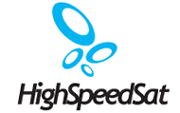

LinkStar
|
| |
Linstar
Satellite Internet |
ViaSat LinkStar
 
|
|
LinkStar™
- Bringing Low-Cost Telephony to a Wide Range of
Markets
LinkStarT
is the highest performance, star-based VSAT system for service
providers, ISPs, and corporate network managers who are
seeking a system based on DVB standards. LinkStar's edge is in
its dynamic bandwidth allocation that makes it more efficient
and faster than other TDMA systems. Terminals can transmit
data to the network hub at speeds up to 1.15 Mbps, with data
downloads of up to 60 Mbps, satisfying bandwidth-intensive
applications using IP data.The system is perfectly suited for
typical Internet usage or for Corporate Wide Area Networking.
The installation process is fast and simple. Thanks to the
extensive reach of satellite coverage, the service is
available throughout Europe, the Middle East, Africa,
Central Asia and the Caribbean!
On
a point-to-multipoint environment, CBCPWorld operates on a
VSAT (Very Small Aperture Terminals) system with a LinkStar
that makes possible a cost-effective networking of either
low-rate services or bandwidth-intensive applications. On a
DVB-based (Digital Video Broadcasting) platform, CBCPWorld is
enabled to build standards-based networks for IP data,
Internet access, video streaming, telemedicine, voice over IP
(Internet Protocol) , or distance learning.
Using the LinkStar broadband VSAT system easily brings out
the following advantages:
- Very high return channel rate.
- Rate-based operation that increases data throughput.
- Guaranteed information rates for each network
location.
- Lower-cost terminals due to fewer hardware components.
- DVB standards for compatibility of platforms.
LinkStar offers several benefits:
- The highest return channel rate on the market
- Rate-based operation that increases your data throughput
- Guaranteed information rates for each network location
- Lower-cost terminals because fewer hardware components
are needed and volumes increase as markets expand
- DVB standards based for compatibility worldwide
LinkStar can operate over C- or Ku-band frequencies, and is
scalable to small or large networks. A Web-based NMS makes it
simple to operate and easy to configure.
|
High Speed Internet without
terrestrial connection
LinkStar IP Access offers the ideal solution for all professionals
who want to become completely independent from their local telco
company. Because today companies and local administrations require
cost-effective broadband Internet connectivity regardless of their
locations, IP Access has been tailored to provide premium Internet
access anytime, anywhere.
The comprehensive IP Access service includes all equipment, space
segment, and high-speed, bi-directional Internet access for a single
monthly subscription.
Europe, the
Middle East, N-Africa and Central Asia
The system comprises of:
1.2m Ø Dish
ODU with Solid State Power Amplifier (2 Watt)
IDU LinkStarT terminal
Az/El Mount LNB/OMT filter
4 subscription packages available:
| package |
Max.
Downlink (kbps) |
Max.
Uplink (kbps) |
IP-Standard:
(1-5 users)
|
512 |
128 |
IP-Business:
(5-10 users)
|
1024 |
256 |
IP-Corporate:
(10-20 users)
|
1024 |
512 |
IP-Professional:
(20+ users)
|
2048 |
1024 |
Africa
and Caribbean
The system comprises of:
2.4m Ø Dish
ODU with Solid State Power Amplifier (5 Watt)
IDU LinkStarT terminal
Az/El Mount
LNB/OMT filter
1 subscription package available:
| package |
Max.
Downlink (kbps) |
Max.
Uplink (kbps) |
IP-Africa:
(up to ± 15 users)
|
2048 |
128 |
DW6040 Voice Appliance provides telephone access via the DIRECWAY
network
The service is
delivered via a terminal adaptor that is added between the equipment
Hughes already provides for data and the phone. The terminal adaptor
plugs into the Hughes satellite transmitter/receiver on one side and
into a standard analog phone on the other. Both boxes are provided
by Hughes, which includes proprietary technology to give voice
traffic priority over data to ensure good voice quality.
Voice is transmitted using the G.729 codec, which reduces the voice
bandwidth to about 12 kilobits per second, Hughes says. Calls made
over the service from Africa, the Middle East or Europe are
transmitted via Eutelsat
W1 or Panamsat >= 10 and aggregated at Hughes'
network operating center in Griesheim, Germany. From there they are
terminated via the Net2Phone network. We haves a similar setup for
the Americas.
The DW6040 is optimized for use with the DIRECWAY system. As each call is initiated, the
DW6040 automatically reserves bandwidth through the DIRECWAY
system and the associated voice stream is prioritized to ensure
end-to-end toll-quality transmission of the call. The DIRECWAY system also facilitates short call setup
times - typically less than four seconds and low end-to-end delay.
Transmission efficiency is improved by compressing the voice
packets. The DIRECWAY NOC equipment routes the voice calls to the
PSTN via an H.323 voice gateway. The voice gateway performs the
conversion from the H.323 protocol and the PSTN signaling. The voice
gateway provides an E1interface to the PSTN. Multiple voice gateways
may be configured at the NOC. A gatekeeper provides the address
resolution between the DW6040 and multiple voice gateways.
The DW6040 is managed by the HNS Vision® Network Management System
(NMS), which provides monitoring and control of the voice appliance,
as well as the DIRECWAY terminal. Downloads of software and
configuration parameters are also performed by the NMS.
Frequently
Asked Questions (FAQ)
1. What
is the difference between the IP-Access and IP-Connect Services?
2. What are the advantages of LinkStar
IP Access compared to terrestrial Internet services?
3. What can I understand by
"Fair-Use Flat Rate"?
4. What are possible applications for
the IP-Connect service?
5. Can I use LinkStar to implement
Voice over IP (VoIP)?
6. How do I connect a PC or a Local
Area Network (LAN) to the LinkStar terminal?
7. Can I connect the LinkStar
terminal to a wireless LAN (W-LAN) network?
8. How many IP addresses do you provide
with each system?
9. Do you provide public IP addresses?
10. Is Linux possible as primary Operating
System?
11. Who can install the system?
12. Can I become an certified installer?
13. Who provides support for LinkStar?
What is the
difference between the IP-Access and IP-Connect Services?
IP-Access provides a Fast Internet Access Service on a
shared basis, with three different data rates up to 2048
kbps downstream and up to 512 kbps upstream. IP-Connect is a
service with a dedicated (i.e. non-shared)data rate from 64
kbs to 8 Mbps allocated exclusively to one customer.
What are
the advantages of LinkStar IP Access compared to terrestrial
Internet services?
IP Access offers a broadband Internet service which is
completely independent from local telco companies. The
persuasive bandwidth is comparable and exceeds the
performance of DSL and cable modems.
The always-on functionality and the fair-use flat rate are
other important features.
What can
I understand by "Fair-Use Flat Rate"?
The concept of "Fair-Use Flat Rate" applies to
the IP-Access service: The subscription to the service is
based on a monthly fee rather than on invoicing for the
traffic on a volume basis. However, in order to guarantee a
fair access for everybody in the user community sharing a
common channel (one or more satellite transponders),
excessive consumption (e.g. streaming media or file sharing
on a peer-to-peer network for many hours) is not allowed. In
case of excessive upload or download volume, the data rate
will be temporarily limited and the user will downgraded on
the priority level.
What are
possible applications for the IP-Connect service?
IP-Connect can be used in principle for all applications
which are based on IP connectivity, including: Internet
access, corporate network infrastructure (WAN, VPN), digital
video streaming (DVB), distance education,
videoconferencing, voice over IP (VoIP).
Can I use
LinkStar to implement Voice over IP (VoIP)?
LinkStar offers the ability to implement VoIP. However,
due to the long satellite path, there is an important round
loop delay of typically 1.5 seconds. This needs a telephone
conversation rather to be simplex, i.e. only one person
speaks at a time. Nevertheless, VoIP based on LinkStar can
be an attractive alternative in geographical regions with
non-existing or poor telephone infrastructure.
How do
I connect a PC or a Local Area Network (LAN) to the LinkStar
terminal?
The indoor unit of the terminal provides a 10/100 Mps
Ethernet Interface which allows you to directly connect a
single computer (via a crossed Ethernet cable) as well as a
network hub, switch, router or proxy server.
Can I
connect the LinkStar terminal to a wireless LAN (W-LAN)
network?
Yes, trough the Ethernet interface it is possible to
connect directly a wireless access point or wireless bridge.
No access PC or workstation is needed.
How many IP
addresses do you provide with each system?
In addition to the IP address of the terminal, as an
option up to 13 private (static) IP addresses can be
provided per station. By attributing these IP addresses to
individual PCs it is possible to set-up a small Local Area
Network (LAN) without the need of a router.
Do you
provide public IP addresses?
For applications based on the fast Internet access
service (IP Access) public addresses are generally not
needed. For special applications which would need a public
IP address,a group of public IP addresses (4, 8, 16.) can
be allocated to each terminal.
Is Linux
possible as primary Operating System?
The LinkStar terminal is an independent station, with no
PC needed for operation. Thus the operation system of the
computers connected to the LAN is irrelevant, as long as it
supports the Internet Protocol (IP). This is the case of all
modern operating systems, including Linux and MAC OS.
Who
can install the system?
The terminal has to be
installed by a certified installer. Indeed special skills
for installing and commissioning are needed, which go well
beyond the installation of a satellite reception-only
system.
Can I
become an certified installer?
Professionals and resellers successfully completing a
one-day seminar can become a certified installer. Prior
experience in installing VSAT equipment is highly useful,
but not a pre-requisite.
Who
provides support for LinkStar?
TISC provides free e-mail and telephone support for all
her LinkStar customers. If needed, exceptionally on-site
support is offered at cost.
|
|
Technical Specifications |
 |
|
Key System Features |
| |
| |
| |
| |
| |
| |
| |
| |
| |
| |
| |
| |
| |
| |
| |
| |
| |
| |
| |
| |
| |
| |
| |
| |
| |
| |
| |
| |
| |
| |
| |
| |
|
Input
Power |
|
90-240 V AC, 47-63 Hz |
|
24 V DC option |
|
Mechanical & Environmental |
|
Shipping Weight: |
3.5
lbs (1.6 kg) |
|
Dimensions: |
9.5"w
x 1.8"h x 10.5" d |
| |
(24
cm x 4.6cm x 26.7cm) |
|
Environmental |
|
0 Celsious to +40 Celsious, RH 95 % noncondensing |
|
|
Are you sick of paying
exorbitant amounts to call Wisconsin, Macedonia, or Middle East?
The new service is designed to
provide long distance IP voice services to remote and underserved
areas of the world, enabling end users to place calls anywhere in
the world at competitive prices. The end users are expected to be
enterprises, and providers of voice and data services to the public,
such as Internet cafes and kiosks.
Net2Phone's VoIP telephony interface has been folded into HNS'
DW6040 voice appliance terminal. The device enables subscribers of
HNS' Direcway service to access Net2Phone's international
long-distance service.
Previous satellite telephony systems delivered spotty performance
because systems couldn't differentiate between voice and data
packets. But this offering identifies voice packets and sends them
over the networks first. It will be sold as an add-on and is
expected to be popular in remote areas in North America, Eastern
Europe, Latin America, Middle East, Africa and other markets where
land-based telecommunications and Internet infrastructure is
under-developed.
The product will costs approximately $400 US for a four-port router.
HNS collaboration with Net2Phone extends the reach of affordable
VoIP international calling worldwide, wherever there is satellite
coverage. Net2Phone's core competency has always been to layer voice
over data networks. Satellite, especially in conjunction with new
DW6040, is the next frontier in data networks that can be powered
with voice.
DVB-RCS
Topology Star Satellite Communication System-LinkStar
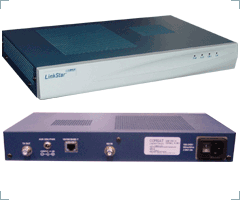
Introduction
LinkStar
is a new two-way broadband satellite communications
system
for Internet Protocol connectivity over satellite. LinkStar
consists
of one or more central stations ¨C the hub ¨C, many remote
VSATs
(Very Small Aperture satellite communication Terminals),
and
appropriate management and control subsystems. The remote VSAT
¨C called the Return Channel Satellite Terminal (RCST) ¨C is
a
small, low cost terminal designed for multimedia broadband
connectivity
in networks with a large number of sites.
Because of the low cost of the remote terminal,LinkStar
is an ideal solution
for large enterprises and service providers (e.g., VPNs and
ISPs)
that need broadband IP connectivity for multimedia
applications
over a large geographic area. A single hub can
connect
up to 10,000 remote terminals, and a multi-hub LinkStar
system
can integrate as many as 100,000 remotes into a single
network.
This document presents a high level description
of the LinkStar
product.
Product Overview
LinkStar
is designed to offer high-throughput connectivity between
a
large number of remote users and one or more hubs,
configured in
a ¡°star¡± network topology. The connectivity is asymmetric,
with a
large capacity outbound satellite link from the hub to the
remote terminals,
and many medium capacity inbound satellite links from
the remotes to the hub. This is depicted in Figure 1 below.
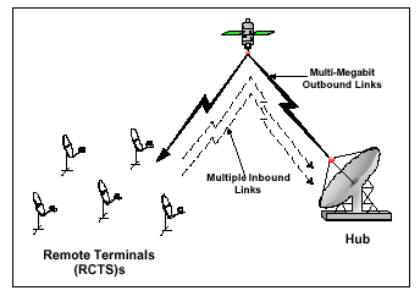
The
LinkStar
system consists of the following:
1. One or more hubs,
2. Return Channel Satellite Terminals (RCST),
3. Network Management System (NMS),
4. Network Control Center (NCC) and Regional NCCs
(RNCC),
and
5. Space Segment over a bent pipe satellite.
The Hub
The central station consists of a large antenna
(typically 6 meters in diameter), transmit and receive RF equipment,
as well as transmit and receive Hub Common Equipment (HCE).
The
transmit HCE consists of a router to interface to the external
IP
network, a DVB-IP encapsulator to embed the IP data into an
MPEG-2
format, a DVB multiplexer, a continuous modulator,
and
a timing clock .
The
receive HCE consists of a timing and distribution MF-TDMA
demodulator
unit and multiple MF-TDMA demodulator
units
for each inbound carrier to be received simultaneously.
Each
demodulator receives an inbound link from a large number
of
remote RCSTs. The number of optional demodulators
depends
on the number of inbound links.Figure 2 depicts the block diagram of
the LinkStar
hub.
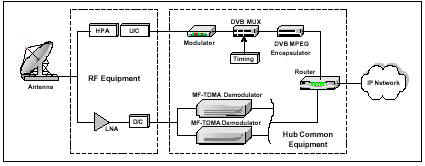
Figure 2 ¨C LinkStar
Hub Block Diagram
The
RCST
The remote RCST (Return Channel Satellite
Terminal) is a small VSAT
consisting of an IDU (indoor unit) and an ODU (outdoor
unit).
The ODU consists of an antenna (96cm, 1.2m, 1.8m or
2.4m)
and an RF power amplifier and low noise receiver.
The
IDU is an integrated unit. The MPEG-2 stream is recovered
from
the outbound signal by an integrated circuit consisting of a
DVB
demodulator and demultiplexer. This logic demodulates
the
outbound signal and the demux recovers the IP packets and
time-stamps
encapsulated in the MPEG-2 stream, which are then
delivered
to the external network via a 10/100 Base-T interface.
 Figure 3 ¨C LinkStar
RCST Block Diagram
Figure 3 ¨C LinkStar
RCST Block Diagram
Management and Control
LinkStar
management and control functions are performed by the NMS
(Network Management System), the NCC (Network Control
System)
and RNCCs (one Regional NCC per outbound carrier).
The
LinkStar
network NMS, because of its web-based design, is
very
user-friendly and flexible. It performs the traditional NMS
functions
of Configuration, Control, Performance, and Alarm
Management,
as well as Accounting, and User
Administration.
It also
provides an interface to download software to the RCSTs from
the
hub.The NMS architecture is illustrated in Figure 4.
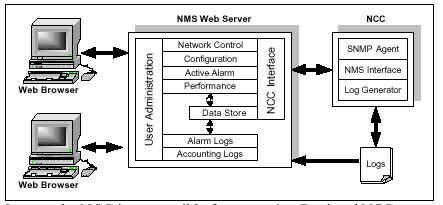 Figure 4 ¨C LinkStar
NMS Architecture
Figure 4 ¨C LinkStar
NMS Architecture
In
turn, the NCC is responsible for managing Regional NCCs
(RNCCs),
managing the overall allocation of blocks of bandwidth
to
individual regions, providing an interface to the NMS, SNMP
code
for configuration and management of the network, and
providing
an interface for the storage and retrieval of configuration
information.
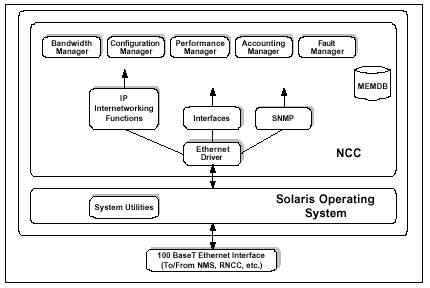
Figure 5 ¨C LinkStar
NCC Architecture
A
LinkStar
network may have one or more RNCCs, one for each
outbound
carrier. The RNCC is responsible for the management
of
all RCSTs associated with its region and outbound carrier.
RNCC
functions include, for example, the allocation of
bandwidth
within the region, acquisition and dissemination of
configuration
information, and management of RCST
acquisition
and synchronization.
Space
Segment
The space segment for a LinkStar
network is of the bent-pipe type,
such as Ku-band and C-band transponders of any global or regional
satellite system. The satellite capacity may be loopback (such
as global or regional coverage) or non-loopback (such as East-West.)
The
LinkStar
space segment is made up of one or more broadband
outbound links, and many inbound links.
Outbound
Link
The outbound link ¨C from the hub to the remotes
¨C is a multi-megabit data
stream that is compliant with the DVB-MPE format.
Information is sent from the hub terminal to the large number
of remotes over this common link, with the following operating
parameters:
¡¤ Transmission
Rate: Selectable rate (5 to 42.5 Msps)
¡¤ Format: Continuous (TDM)
¡¤ Modulation/FEC: ETSI-compliant (EN-301210) modulation and FEC
(forward error correction) formats:
(a) QPSK with concatenated coding (inner convolutional FEC
and
outer
RS), or
(b) 8-PSK with concatenated coding (inner Pragmatic Trellis
Coded
Modulation (PTCM), outer RS)
¡¤ Transport Stream: MPEG-2 and DVB Multi-Protocol Encapsulation
(DVB-MPE) format for IP data.
Inbound
Link
In the inbound direction ¨C from the remotes to the hub ¨C
the LinkStar
network uses multiple links that are shared by associated groups of
remote terminals. The inbound link is compliant with a subset of the
DVB-RCS standard, with the following operating parameters:
¡¤ Transmission Rate: Selectable rate (156.2, 312.5, 625 or 1250
Ksym/sec)
¡¤ Format: Demand assigned bursts over multiple TDMA (Time
Division Multiple Access) carriers
¡¤ Modulation/FEC: Burst QPSK with Rate 2/3 Turbo Code FEC.
¡¤ TCP Acceleration: TCP ¡°spoofing¡± support.
Key
Features
Other LinkStar
important features are indicated below.
¡¤
Network limitation ¨C 5,000+ RCSTs supported per outbound
carrier, expandable to 100,000 terminals in total.
¡¤
Two-way satellite transmission ¨C 5 to 42.5 Msps outbound
carrier,
and multiple 0.156 to 1.25 Msps inbound carriers, with bandwidth
automatically allocated based on demand.
¡¤
Many Internet Protocol enhancements:
(a) Multicast within user groups
(b) Full routing protocols at remote (RIP1 and RIP2) and at
hub
(BGP4)
(c) Diffserv-based QoS
(d) TCP acceleration (spoofing).
¡¤
Comprehensive NMS/NCC functionality:
(a) Support for all NMS ISO elements ¨C configuration,
control,
performance, alarm, and administration (authentication,
accounting,etc.)
(b) User-friendly Web-based GUI interfaces
(c) SNMP support
¡¤
Support for C-band, Ku-band, and Ka-band RFT
LinkStar
Applications
¡¤
Internet
Service Providers
¡¤
Private Corporate Networks
¡¤
Virtual Private Networks
¡¤
Telemedicine
¡¤
Voice over IP
¡¤
Distance Education
Summary
Cost-effective and flexible large-scale two-way broadband
multimedia networks are now possible with LinkStar
S
, the powerful new VSAT
platform from Lockheed Martin. This new satellite communications
platform combines the inherent flexibility and immediate
infrastructure made possible by existing satellite systems operating
at C, Ku and Ka frequency bands, with native support for Internet
Protocol, flexible network connectivity options, and
bandwidth-on-demand.
With the convergence of applications over IP, many new
applications and business opportunities arise every day in
geographic regions with insufficient or nonexistent copper and fiber
infrastructure. LinkStar
now becomes the solution of choice for this type of growing
requirement.
High-Throughput
Connectivity Over Satellite: LINKSTARTM
To meet the region's
ever-growing demand for broadband services, LMGT now offers a new
two-way broadband satellite communications system for Internet
protocol connectivity over satellite - LINKSTARO. LINKSTAR consists
of one or more central stations - the hub -, many remote VSATs), and
appropriate management and control subsystems. The remote VSAT -
called the Return Channel Satellite Terminal (RCST) - is a small,
low cost terminal designed for multimedia broadband connectivity in
networks with a large number of sites. Because of the low cost of
the remote terminal, LINKSTAR is an ideal solution for large
enterprises and service providers (e.g., VPNs and ISPs) that need
broadband IP connectivity for multimedia applications over a large
geographic area. A single hub can connect up to 10,000 remote
terminals, and a multi-hub LINKSTAR system can integrate as many as
100,000 remotes into a single network.
LINKSTAR is designed
to offer high-throughput connectivity between a large number of
remote users and one or more hubs, configured in a "star"
network topology. The connectivity is asymmetric, with a large
capacity outbound satellite link from the hub to the remote
terminals, and many medium capacity inbound satellite links from the
remotes to the hub. This is depicted in Figure 1 below. LINKSTAR
utilizes an outbound digital video broadcasting (DVB) channel of
selectable rate up to 60 Mbps, and a broadband satellite return
channel of selectable rate up to 1.150Mbps.
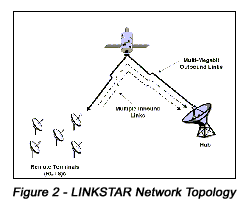
The central
station consists of a large antenna (typically 6 meters in
diameter), transmit and receive RF equipment, as well as transmit
and receive Hub Common Equipment (HCE). The transmit HCE consists of
a router to interface to the external IP network, a DVB-IP
encapsulator to embed the IP data into an MPEG-2 format, a DVB
multiplexer, a continuous modulator, and a timing clock. The receive
HCE consists of a timing and distribution MF-TDMA demodulator unit
and multiple MF-TDMA demodulator units for each inbound carrier to
be received simultaneously. Each demodulator receives an inbound
link from a large number of remote RCSTs. The number of optional
demodulators depends on the number of inbound links.
The remote RCST
(Return Channel Satellite Terminal) is a small VSAT consisting of an
IDU (indoor unit) and an ODU (outdoor unit). The ODU consists of an
antenna (96cm, 1.2m, 1.8m or 2.4m) and an RF power amplifier and low
noise receiver. The IDU is an integrated unit. The MPEG-2 stream is
recovered from the outbound signal by an integrated circuit
consisting of a DVB demodulator and demultiplexer. This logic
demodulates the outbound signal and the demux recovers the IP
packets and time-stamps encapsulated in the MPEG-2 stream, which are
then delivered to the external network via a 10/100 Base-T
interface.
LINKSTAR management
and control functions are performed by the NMS (Network Management
System), the NCC (Network Control Center) and RNCCs (one Regional
NCC per outbound carrier). The LINKSTAR network NMS, because of its
web-based design, is very user-friendly and flexible. It performs
the traditional NMS functions of Configuration, Control,
Performance, and Alarm Management, as well as Accounting, and User
Administration. It also provides an interface to download software
to the RCSTs from the hub. A LINKSTAR network may have one or more
RNCCs, for each outbound carrier. The RNCC is responsible for the
management of all RCSTs associated with its region and outbound
carrier. RNCC functions include, for example, the allocation of
bandwidth within the region, acquisition and dissemination of
configuration information, and management of RCST acquisition and
synchronization.
The LINKSTAR product
is particularly well suited for today's broadband applications.
Service providers and multinational corporations can establish
extremely economical star networks using one VSAT platform. This is
important for a service provider offering virtual private networks (VPNs),
or for multinational corporations, since star networks support many
applications over the Internet. Typical applications include
Internet access, IP corporate infrastructure, digital video
broadcast (DVB), distance education, videoconferencing, video
streaming, and voice over IP (VoIP). Popular LINKSTAR network
examples include Private Corporate Networks, Virtual Private
Networks, Internet Service Provider Access, telemedicine, and
distance education. While these applications have experienced
increased importance in all regions of the world, the Asia-Pacific
region stands to be one of the most marketable, given its vast
population and geographic area, and ever-growing demand for
telecommunications connectivities of all types.
The LINKSTAR
product is designed to support large amounts of asymmetric traffic,
making it ideal for Internet Service Providers (ISPs). As an ISP
increases its coverage beyond the metropolitan areas, low cost
broadband IP delivery over satellite becomes increasingly valuable.
The hub is installed within easy access to the core of the Internet,
and remote terminals are installed at large client locations, or at
ISP remote POP (Point of Presence) locations. For example,
multinational ISPs serving Europe can extend their services into
more remote locations - e.g., the Middle East and Asia. If each RCST
depicted in Figure 2 represents a POP connection to local and/or
corporate users, then the figure shows an ISP application using one
or more high capacity (e.g., 42.5 Msps) carriers designated as
outbound, and several smaller carriers (156.2 to 4580 ksps)
designated as inbound. The outbound carriers are used to broadcast
IP content to all POP locations, each of which serve a large
community of dial-in users - or a large corporate user. The inbound
carriers are shared among each POP to transport requests to the
content-provider. The inbound carriers can also be used for
administrative traffic (e-mail, technical support, reports, request
for spare equipment, voice, etc.) among the individual POPs in a
single satellite hop.
Broadband On-demand
Managed Networks: The LINKWAY( Platform and Link OneSM
Service.
LMGT recognized the
growing market demand for satellite-based broadband, on-demand
virtual networks that can provide connectivity for a variety of
applications such as voice, data, video, and Internet. To meet this
demand, the company developed a platform and satellite system
network that employs a multi-frequency TDMA (time division multiple
access) architecture which can achieve extremely high efficiency and
flexibility in satellite bandwidth management. The LMGT proprietary
LINKWAYa unit is a multi-carrier, multi-rate, TDMA VSAT-like
platform that works with conventional C or Ku-band satellites.
LINKWAY serves as the operating platform for the service, while the
rest of the system utilizes existing off the shelf, commercially
available earth stations, including low-cost, compact VSAT-like
terminals. Unlike traditional VSAT designs, this system offers high
data rates (up to 2-4 Mbps/VSAT), full-mesh, single-hop connectivity
and high-speed local area network interconnection services. A basic
LINKWAY terminal contains a 10 BaseT IP port, and any two of three
additional interfaces: ATM, Frame Relay or ISDN. All electronics,
including the satellite modem, are housed on a single board in a low
profile chassis. The IDU is able to access multiple locations and to
support various services to multiple locations.
LMGT's managed
network service over satellite is marketed as Link OneSM and
provides integrated circuit-switched and packet services over a
single satellite hop. Full-mesh connectivity between any user
devices connected to the network is available for an essentially
unlimited number of users at multiple sites. Link One service can be
implemented in a variety of topologies, the most common being star,
mesh and hybrid. The Link One network consists of a Network Control
Center (NCC) and a number of traffic terminals. One traffic terminal
is designated as the Master Reference Terminal (MRT) to provide TDMA
timing. The system is controlled dynamically by the full-featured
NCC that runs the Network Management System (NMS) Server and
performs the bandwidth management function. Figure 3 depicts the
utility of the various networking applications and protocols that
are feasible in a Link One network.

Link One is
particularly suited as a network service solution for entities
operating in regions where the nodes are dispersed over wide
geographic areas and the existing communications infrastructure is
minimal and/or unreliable. For example, a major bank, energy company
or international service organization with requirements for a
combination of telecommunications services (data, voice, Internet
and videoconferencing) that desires the ability for any site to
communicate with any other site in its private network would find
Link One the ideal platform for delivering this capability. Figure 4
illustrates such a hypothetical network serving locations in the
Asia-Pacific region. In this example, six widely-separated nodes are
connected in a mesh (hubless) single-hop configuration as a private
network. Future expansion (new nodes, bandwidth size or both) can be
easily accommodated with minimal impact to the existing network.
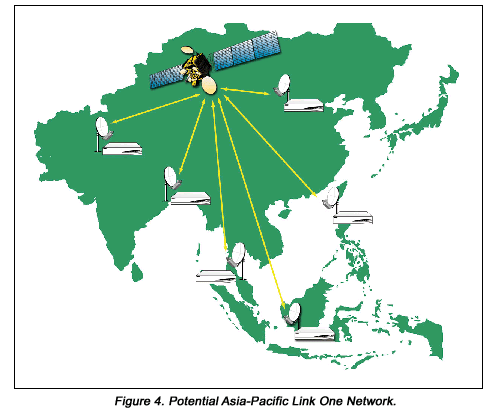
Summary.
With its
forward-looking broadband-over-satellite products, and its
established avenues of regional presence in both satellite services
and satellite capacity business investments, Lockheed Martin Global
Telecommunications continues to offer the Asia-Pacific market solid
solutions to rapidly evolving telecommunications needs. These
capabilities combine years of technical expertise with the
flexibility needed to adjust to the demands that the future
inevitably produces.
|
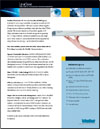 |
Click on
the thumbnail to download LinkStar
System Configuration
Data Sheet
(PDF, 152K) |
|
| |

|
| |
Click
here if you need to download free Acrobat Reader®
software |
|





 Figure 3 ¨C LinkStar
RCST Block Diagram
Figure 3 ¨C LinkStar
RCST Block Diagram




